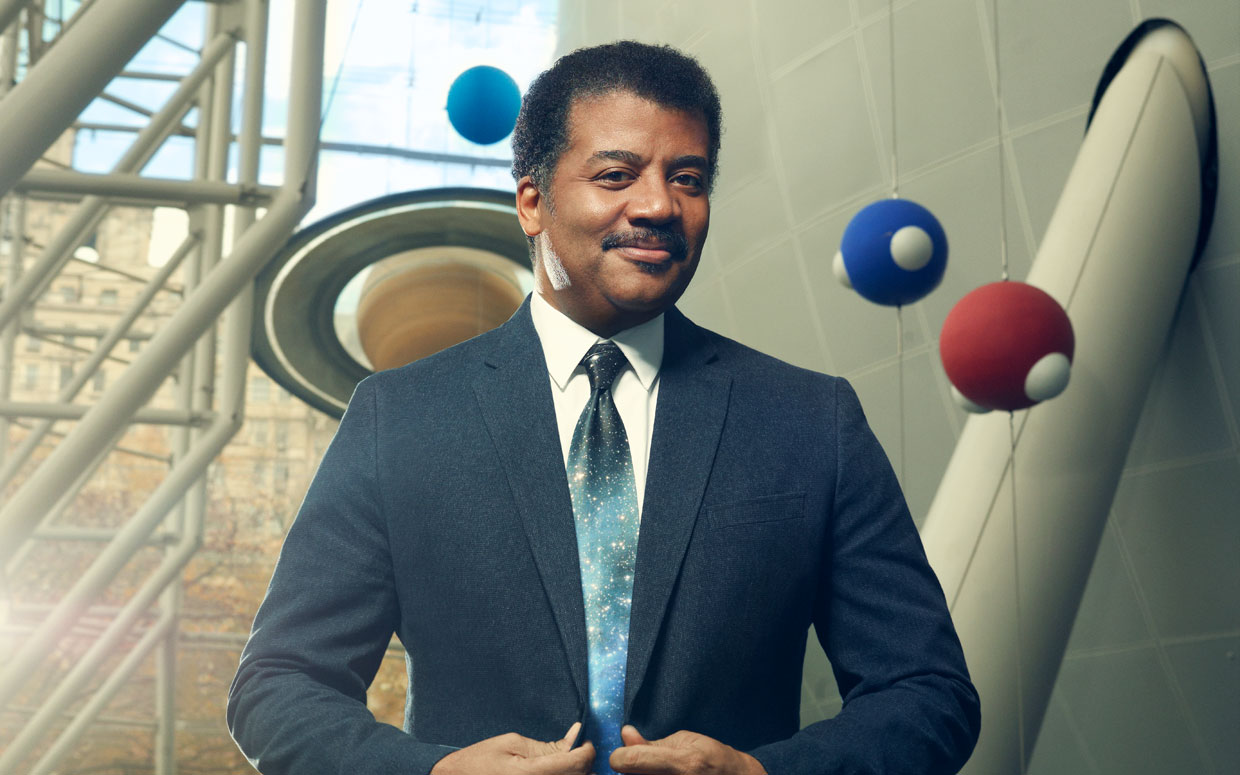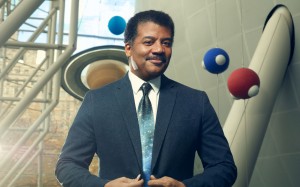
This week’s open threads have highlighted the accomplishments of several African-American Astronomers and Astrophysicists. Today’s post is going to focus on the current host of Cosmos: A Spacetime Odyssey.
Neil deGrasse Tyson ( born October 5, 1958) is an American astrophysicist, author, and science communicator. He is currently the Frederick P. Rose Director of the Hayden Planetarium at the Rose Center for Earth and Space and a research associate in the department of astrophysics at the American Museum of Natural History. From 2006 to 2011, he hosted the educational science television show NOVA ScienceNow on PBS and has been a frequent guest on The Daily Show, The Colbert Report, Real Time with Bill Maher, and Jeopardy!. Tyson is the host of Cosmos: A Spacetime Odyssey, an update to Carl Sagan’s Cosmos: A Personal Voyage television series; the updated series started in March 2014.
Tyson was born as the second of three children in the borough of Manhattan in New York City and was raised in the Bronx. His mother, Sunchita Marie (Feliciano) Tyson, was a gerontologist, and his father, Cyril deGrasse Tyson, was a sociologist, human resource commissioner for the New York City mayor John Lindsay, and the first Director of Harlem Youth Opportunities Unlimited.
From kindergarten through high school Tyson attended public schools in New York City, all in the Bronx, which included PS 36, PS 81, Riverdale Kingsbridge Academy (MS 141), and The Bronx High School of Science (1972–76) where he was captain of the wrestling team, and editor-in-chief of the school’s Physical Science Journal. Tyson had an abiding interest in astronomy since he was nine years old, following his visit to Pennsylvania and seeing the stars, saying “it looks like the Hayden Planetarium”. He obsessively studied astronomy in his teens, and eventually even gained some fame in the astronomy community by giving lectures on the subject at the age of fifteen. Tyson recalls that “so strong was that imprint [of the night sky] that I’m certain that I had no choice in the matter, that in fact, the universe called me.”
Astronomer Carl Sagan, who was a faculty member at Cornell University, tried to recruit Tyson to Cornell for undergraduate studies. In an interview with writer Daniel Simone, Tyson said:
Interestingly, when I applied to Cornell, my application dripped of my passion for the study and research of the Universe. Somehow the admissions office brought my application to the attention of the late Dr. Sagan, and he actually took the initiative and care to contact me. He was very inspirational and a most powerful influence. Dr. Sagan was as great as the universe, an effective mentor.
Tyson revisited this moment on his first episode of Cosmos: A Spacetime Odyssey. Pulling out a 1975 calendar belonging to the famous astronomer, he finds the day Sagan invited his 17-year-old self to spend a day in Ithaca. Sagan had offered to put him up for the night if his bus back to the Bronx didn’t come. Tyson said, “I already knew I wanted to become a scientist. But that afternoon, I learned from Carl the kind of person I wanted to become.”
Tyson chose to attend Harvard University, however, where he majored in physics and lived in Currier House. He was a member of the crew team during his freshman year, but returned to wrestling, eventually lettering in his senior year. In addition to wrestling and rowing in college, he was active in dance, in styles including jazz, ballet, Afro-Caribbean, and Latin Ballroom. Tyson earned a Bachelor of Arts in physics from Harvard in 1980 and began his graduate work at the University of Texas at Austin; he was unable to complete his Ph.D. because his thesis committee voted to dissolve itself and he received a Master of Arts in astronomy in 1983. In 1985, he won a gold medal with the University of Texas dance team at a national tournament in the International Latin Ballroom style. He was a lecturer at the University of Maryland from 1986-1987.
In 1988, Tyson was accepted into the astronomy graduate program at Columbia University, where he earned a Master of Philosophy in astrophysics in 1989, and a Doctor of Philosophy in astrophysics in 1991 under the supervision of Professor R. Michael Rich (now at UCLA). Rich obtained funding to support Tyson’s doctoral research from NASA and the ARCS foundation enabling Tyson to attend international meetings in Italy, Switzerland, Chile, and South Africa and to hire students to help him with data reduction. In the course of his thesis work, he observed using the 0.91 m telescope at the Cerro Tololo Inter-American Observatory in Chile, where he obtained images for the Calán/Tololo Supernova Survey helping to further their work in establishing Type Ia Supernovae as standard candles. These papers comprised part of the discovery papers of the use of Type Ia supernovae to measure distances, which led to the improved measurement of the Hubble constant and discovery of dark energy in 1998. He was 18th author on a paper with Brian Schmidt, a future winner of the 2011 Nobel Prize in Physics, in the study of the measurement of distances to Type II Supernovae and the Hubble constant.
During his thesis work at Columbia University, Tyson became acquainted with Professor David Spergel at Princeton University, who visited Columbia University in the course of collaborating with his thesis advisor on the Galactic bulge. Tyson was a postdoctoral research fellow at Princeton University from 1991 to 1994 and it was during this period that the project to renovate the Hayden Planetarium was conceived.
Tyson’s research has focused on observations in cosmology, stellar evolution, galactic astronomy, bulges, and stellar formation. He has held numerous positions at institutions including the University of Maryland, Princeton University, the American Museum of Natural History, and Hayden Planetarium.
Tyson has written a number of popular books on astronomy. In 1995, he began to write the “Universe” column for Natural History magazine. In a column he authored for the magazine in 2002, Tyson coined the term “Manhattanhenge” to describe the two days annually on which the evening sun aligns with the cross streets of the street grid in Manhattan, making the sunset visible along unobstructed side streets. Tyson’s column also influenced his work as a professor with The Great Courses.
In 2001, US President George W. Bush appointed Tyson to serve on the Commission on the Future of the United States Aerospace Industry and in 2004 to serve on the President’s Commission on Implementation of United States Space Exploration Policy, the latter better known as the “Moon, Mars, and Beyond” commission. Soon afterward he was awarded the NASA Distinguished Public Service Medal, the highest civilian honor bestowed by NASA.
In 2004, he hosted the four-part Origins miniseries of PBS’s Nova, and, with Donald Goldsmith, co-authored the companion volume for this series, Origins: Fourteen Billion Years Of Cosmic Evolution. He again collaborated with Goldsmith as the narrator on the documentary 400 Years of the Telescope, which premiered on PBS in April 2009.
As director of the Hayden Planetarium, Tyson bucked traditional thinking in order to keep Plutofrom being referred to as the ninth planet in exhibits at the center. Tyson has explained that he wanted to look at commonalities between objects, grouping the terrestrial planets together, the gas giants together, and Pluto with like objects and to get away from simply counting the planets. He has stated on The Colbert Report, The Daily Show, and BBC Horizon that this decision has resulted in large amounts of hate mail, much of it from children. In 2006, the International Astronomical Union (IAU) confirmed this assessment by changing Pluto to the dwarf planet classification. Daniel Simone wrote of the interview with Tyson describing his frustration. “For a while, we were not very popular here at the Hayden Planetarium.”
Tyson has been vice president, president, and chairman of the board of the Planetary Society. He was also the host of the PBS program Nova Science Now until 2011. He attended and was a speaker at the Beyond Belief: Science, Religion, Reason and Survival symposium on November 2006. In 2007, Tyson was chosen to be a regular on The History Channel’s popular series The Universe.
In April 2011, Tyson was the keynote speaker at the 93rd International Convention of the Phi Theta Kappa International Honor Society of the Two-year School. Tyson has argued that the concept of intelligent design thwarts the advance of scientific knowledge.
He has written and broadcast extensively about his views of science, spirituality, and the spirituality of science including the essays, “The Perimeter of Ignorance” and “Holy Wars”, both appearing in Natural History magazine and the 2006 Beyond Belief workshop. Tyson has collaborated with evolutionary biologist Richard Dawkins and presented talks with him on religion and science. When asked if he believed in a higher power, Tyson responded:
Every account of a higher power that I’ve seen described, of all religions that I’ve seen, include many statements with regard to the benevolence of that power. When I look at the universe and all the ways the universe wants to kill us, I find it hard to reconcile that with statements of beneficence.
In an interview with Big Think, Tyson said, “So what people are really after is my stance on religion or spirituality or God, and I would say if I had to find a word that came closest, I would say agnostic… at the end of the day I’d rather not be any category at all.” During the interview “Called by the Universe: A conversation with Neil deGrasse Tyson” in 2009, Tyson said: “I can’t agree to the claims by atheists that I’m one of that community. I don’t have the time, energy, interest of conducting myself that way… I’m not trying to convert people. I don’t care.”

